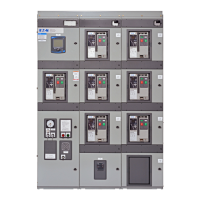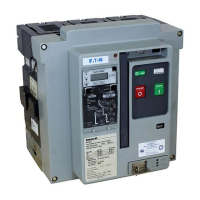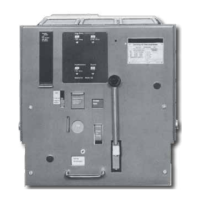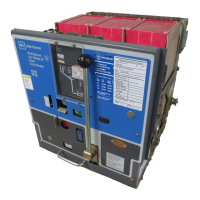8
1
1
1
1
1
1
1
1
1
1
1
1
1
1
1
1
1
1
1
1
MAGNUM PRODUCT GUIDE CA013002EN—April 2017 www.eaton.com52
Accessory devices and connections
Overview of Magnum accessories
A variety of accessory devices are available for use with
Magnum circuit breakers. Unless otherwise stated, they are
all considered optional devices in the sense that they are not
provided as standard on a manually operated circuit breaker.
Available accessories are identified here and discussed in
general terms. For more detailed information and/or installation
instructions, refer to the individual instruction leaflets available
on www.eaton.com/magnum.
Magnum circuit breaker accessories are designed to fit all frame
sizes. The accessories fall into one of three categories:
•
Plug-in Electrical
•
Internal Electrical
•
Mechanical P
Plug-in electrical accessories
There are several Magnum plug-in electrical accessories.
Three types (ST, SR, UVR) can be viewed for identification by
name and rating through viewing windows located in the right
front of the breaker.
All of these below are plug-in type and can be factory installed or
field installed using a UL Listed kit. The plug-in accessories are:
1. Shunt Trip (ST) (Through the window)
2. Spring Release (SR) (Through the window)
3. Undervoltage Release (UVR) (Through the window)
4. Auxiliary Switch
5. Latch Check Switch
Accessory viewing windows
Through-the window electrical accessories
•
Shunt Trip (ST)
The shunt trip is an optional device on circuit breakers.
It opens the circuit breaker instantaneously when its coil is
energized by a voltage input. A total of two shunt trips can be
mounted on a Magnum breaker. Two different shunt trip types
are available:
• The continuous duty coil (or 100% rated) type can be
continuously energized. It is useful in applications where it is
desired to keep the breaker tripped open.
• The shunt trip type that has a cutoff switch removes voltage
from the coil once the breaker contacts are opened.
ote:N Do not use a shunt trip monitoring circuit with a continuous duty
shunt trip.
Table 13. Shunt trip ratings
Control
voltages
Operational
voltage range
70 –110%
Inrush power
consumption
Opening
time (ms)
24 Vdc 17–26 Vdc 250 W 35
48 Vdc 34–53 Vdc 250 W 35
60 Vdc 42–66 Vdc 300 W 35
110–125 Vdc 77–138 Vdc 450 W 35
220–250 Vdc 154–275 Vdc 450 W 35
110–127 Vac 77–140 Vac 450 VA 35
208–240 Vac 146–264 Vac 450 VA 35
Required for less than 35 ms.
Table 14. Continuous duty shunt trip
Control
voltages
Operational
voltage range
70 –110%
Inrush/
continuous
power
consumption
Opening
time
24 Vdc 17–26 250 W/18 W 35
48 Vdc 34–53 275 W/18 W 35
60 Vdc 42–66 275 W/18 W 35
110–125 Vdc 77–138 450 W/10 W 35
220–250 Vdc 154–275 450 W/10 W 35
110–127 Vac 77–140 450 VA/10 VA 35
208–240 Vac 146–264 400 VA/10 VA 35
Shunt trip with cutoff switch
Shunt trip switch installed
1
1
Courtesy of NationalSwitchgear.com

